Symphyotrichum lanceolatum
Symphyotrichum lanceolatum (formerly Aster lanceolatus) is a species of flowering plant in the family Asteraceae native to North America. Common names include lance-leaved aster, panicled aster, and white panicled aster. It is a perennial, herbaceous plant that may reach 1.5 meters (5 feet) tall or more, sometimes approaching 2 meters (6.6 feet). It has a stout rhizome and can spread to form a clonal colony. The species is currently divided into five varieties which have minor differences in appearance and vary in chromosome counts as well as distribution, with some overlap.[2]
| Symphyotrichum lanceolatum | |
|---|---|
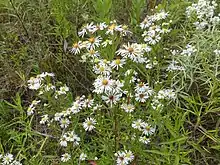 | |
.jpg.webp) | |
| Scientific classification | |
| Kingdom: | Plantae |
| Clade: | Tracheophytes |
| Clade: | Angiosperms |
| Clade: | Eudicots |
| Clade: | Asterids |
| Order: | Asterales |
| Family: | Asteraceae |
| Genus: | Symphyotrichum |
| Species: | S. lanceolatum |
| Binomial name | |
| Symphyotrichum lanceolatum | |
 | |
| Native range of Symphyotrichum lanceolatum.[2][3] For infraspecies ranges, see text. | |
| Synonyms | |
|
Basionym[4]
Infraspecies
| |
As composite flowers, each flower head has many tiny florets put together into what appear as one, as do all plants in the family Asteraceae. The flowers of panicled aster have 16–50 white ray florets that are up to 10 millimeters long and sometimes tinged pink or purple. The flower centers begin as yellow and become purple as they mature. There are roughly 20–40 disk florets in the center of each flower head, each with five lobes that may spread when open. The leaves are generally hairless but may feel slightly rough to the touch on the top because of tiny bristles. Branching of the inflorescences is in panicles.[2]
Symphyotrichum lanceolatum occurs in a wide variety of mostly moist and open habitats, including riparian areas (areas between land and a river or stream), meadows, and ditches.[10] It is a conservationally secure species[1] whose late-summer and fall appearing flowers play an important role for late-season pollinators and nectar-seeking insects such as bumblebees, wasps, and hoverflies.[11] In addition to being used by indigenous peoples for medicinal purposes,[12] it has been cultivated as an ornamental garden plant and used in the cut flower industry.[13]
This species spreads extensively via its rhizomes and can reproduce by wind-blown seed.[13] Because of its rhizomatic spreading and its production of chemicals that can be detrimental to other plants around it, the species can do damage to ecosystems outside of its native range, as it has in Europe where it has been introduced.[14]
Name
Symphyotrichum lanceolatum is commonly known as lance-leaved aster, panicled aster, white panicled aster,[2] tall white aster,[15] eastern line aster, lance-leaf aster, and white-panicle aster.[16] Along with other asters that bloom in the fall, Symphyotrichum lanceolatum may be called a Michaelmas Daisy, and narrow-leaf Michaelmas daisy is also one of its common names.[16] S. lanceolatum var. interior has a common name of interior white aster,[17] and S. lanceolatum var. latifolium has a common name of broadleaf panicled aster.[18] S. lanceolatum var. hesperium common names include western line aster, western willow aster, Wooten's aster, and Siskiyou aster.[19] Another species in the family Asteraceae, Eucephalus glabratus, is also commonly known as Siskiyou aster.[20]
Aster comes from the Ancient Greek word ἀστήρ (astḗr), meaning star, referring to the shape of the flower. The word aster was used to describe a star-like flower as early as 1542 in German physician and botanist Leonhart Fuchs' book De historia stirpium commentarii insignes, Latin for Notable Commentaries on the History of Plants. An old common name for Astereae species using the suffix -wort is starwort, also spelled star-wort or star wort. An early use of this name can be found in the same work by Fuchs as Sternkraut, translated from German literally as star herb.[21]
The specific epithet (second part of the binomial name) lanceolatum is a Latin adjective meaning "lance-shaped."[11]:1101 The genus name Symphyotrichum is a combining of Ancient Greek words meaning "junction of hair."[11]:1095
Description
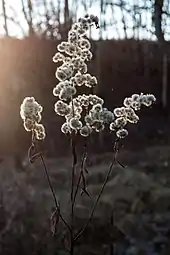
This perennial herb has a thick, erect stem that often grows 1.5 meters (5 feet) tall or more, sometimes approaching 2 meters (6.6 feet). It has a stout rhizome and can spread to form a colony. The leaf blades have winged petioles and may sheath the stem at their bases. The largest leaves, near the base of the plant, are up to about 15 centimeters (6 inches) long. Those higher on the stem are smaller. The lower leaves may have toothed edges. The inflorescence is usually a large, branching array of many flower heads of varying size. There are 16 to 50 ray florets per head, each measuring 3 to 14 millimeters long, in shades of blue, pink, or white. The disk florets bloom yellow and turn purple.[2]
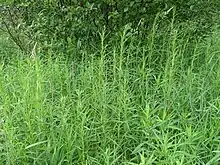
Chromosomes
Symphyotrichum lanceolatum has a base number of x = 8.[22] Tetraploid, pentaploid, hexaploid, septaploid, and octaploid cytotypes with respective chromosome counts of 32, 40, 48, 56, and 64 have been reported, depending on the infraspecies, as follows:
- S. lanceolatum var. hesperium: 2n = 8x = 64.[3]
- S. lanceolatum var. hirsuticaule: 2n = 4x = 32.[23]
- S. lanceolatum var. interior: 2n = 6x = 48 and 2n = 8x = 64.[24]
- S. lanceolatum var. lanceolatum: 2n = 4x = 32, 2n = 5x = 40, 2n = 6x = 48, 2n = 7x = 56, and 2n = 8x = 64.[10]
- S. lanceolatum var. latifolium: 2n = 8x = 64.[25]
Taxonomy
Symphyotrichum lateriflorum is classified in the subgenus Symphyotrichum, section Symphyotrichum, subsection Dumosi.[26] It is one of sixteen "bushy asters and relatives".[22]
This species may be divided into two subspecies and five varieties:[2]
- S. lanceolatum subsp. hesperium
- S. lanceolatum var. hesperium - northern Canada, western United States and northwestern Mexico
- S. lanceolatum subsp. lanceolatum
- S. lanceolatum var. hirsuticaule - great lakes region of Canada and the United States
- S. lanceolatum var. interior - eastern Canada and northeastern United States
- S. lanceolatum var. latifolium - eastern Canada and eastern United States
- S. lanceolatum var. lanceolatum - eastern and central Canada and United States, also introduced to Europe
The hybrid of this species with Symphyotrichum novi-belgii, known as Sympyotrichum × salignum, originates in cultivation but is now naturalized in Europe. Hybrids have also been reported with S. boreale, S. laeve, S. lateriflorum, S. puniceum and S. racemosum.[10]
Symphyotrichum lanceolatum was formerly included in the large genus Aster as Aster lanceolatus. However, this broad circumscription of Aster is polyphyletic and the North American asters are now mostly classified in Symphyotrichum and several other genera.[27]
Distribution and habitat
Symphyotrichum lanceolatum is native to much of Canada excepting the far north, to most of the United States, and to northwestern Mexico in Baja California, Sonora and Chihuahua.[2][3] In its native range, it occurs in a wide variety of mostly moist, open habitats, including riparian areas, meadows, and ditches. Native distribution and habitat varies among the infraspecies, and details are shown in the table "Distribution and habitat among species and infraspecies."[10][3]
Symphyotrichum lanceolatum has been introduced and naturalized in many parts of Europe, from Belgium to Serbia to Latvia.[14][28][29] As an introduced species in Europe, it occurs in disturbed man-made habitats, as well as in riparian areas as an invasive species.[29] Although introduced there, it is not on the European Union's List of invasive alien species of Union concern.[30]
| Native range map | Native distribution | Habitat | Elevation | |
|---|---|---|---|---|
| Species as a whole[2] |  |
Canada and the United States except Yukon, Nunavut, Alaska, Hawaii, and Delaware;[2] Mexican states of Baja California, Sonora, and Chihuahua.[3] | See infraspecies | See infraspecies |
| Var. hesperium[3] |  |
Canadian provinces and territories of Northwest Territories, British Columbia, Alberta, Saskatchewan, Manitoba, Ontario, and Quebec; in Wisconsin east of the Mississippi River, in all U.S. states west of the Mississippi River except Alaska, Hawaii, Missouri, Arkansas, and Louisiana; Mexican states of Baja California, Sonora, and Chihuahua.[3] | On the edges of streams in prairies, wet meadows, open slopes of mountainous pine forests, roadside ditches; can live in lime (chalky) soils[3] | 10–2,700 m (33–8,858 ft)[3] |
| Var. hirsuticaule[23] | 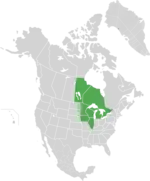 |
Only in the Canadian provinces of Manitoba and Ontario and the U.S. states of Minnesota, Iowa, Wisconsin, Illinois, and Michigan.[23] | "Mucky soils on glacial deposits"[23] | 100–300 m (328–984 ft)[23] |
| Var. interior[24] |  |
Canadian provinces of Ontario and Quebec; and, the U.S. from Nebraska to Pennsylvania (including Michigan), up to New York and Vermont, back down to Kentucky and only as far south as Arkansas, and as far west as Oklahoma.[24] | Along streams in lowlands[24] | 10–400 m (33–1,312 ft)[24] |
| Var. lanceolatum[10] |  |
Canadian provinces except British Columbia (no territories); in the U.S., from North Dakota east to Maine excluding New York, south to Virginia excluding Delaware, west to Kansas, and the four states south of Kansas — Oklahoma, Arkansas, Louisiana, and Texas.[10] | Stream banks, thicket borders, meadows, fields, and ditches[10] | 0–900 m (0–2,953 ft)[10] |
| Var. latifolium[25] | 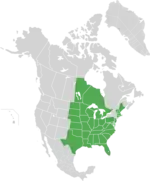 |
Manitoba and Ontario; in the U.S., all states east of the Mississippi River except New York and Delaware, all states on the west Mississippi River border, and the states directly west of those states (from North Dakota in the north to Texas in the south).[25] | Thickets, deciduous woods borders, stream banks, and ditches[25] | 0–800 m (0–2,625 ft)[25] |
Ecology
In addition to dispersal by wind-blown seed, Symphyotrichum lanceolatum spreads extensively by rhizomes to create large clones. Although these clones do not dominate habitats in North America, growing in association with grasses, goldenrods and other asters,[13] in Europe it is an invasive species that excludes native plants in riparian habitats. This invasiveness has been linked to allelopathic compounds in S. lanceolatum tissue and their effect on native European plants.[14] Viable seed production in Europe seems to be limited, and the species largely spreads there via rhizomes.[29]
The species is visited by a wide variety of pollinating insects, including bees, flies, moths, and wasps. Cross-fertilisation is usually required to produce viable seed, and as such large clones may have low seed production.[13]
Several gall midge species are known to form galls on Symphyotrichum lanceolatum, including Rhopalomyia asteriflorae and Asteromyia paniculata. Leaf-mining insects known to feed on this species include Anoplitis inaequalis, Agromyza curvipalpis, Phytomyza albiceps, Microrphopala xerene, and Sumitrosis inaequalis. Younger instars of Gorgone Checkerspot caterpillars will feed on S. lanceolatum.[13]
Conservation
NatureServe lists the species Symphyotrichum lanceolatum as a whole as Secure (G5) worldwide, Vulnerable (S3) in Iowa, and Imperiled (S2) in North Carolina and Newfoundland.[1]
S. lanceolatum subsp. hesperium, S. lanceolatum subsp. lanceolatum, S. lanceolatum var. interior, and S. lanceolatum var. latifolium are all listed as a Secure Subspecies (T5) globally.[31][32][17][18] NatureServe has no global ranking for S. lanceolatum var. hirsuticaule.[33]
In individual states and provinces of the United States and Canada, Symphyotrichum lanceolatum subsp. hesperium is Vulnerable (S3) in Wyoming, and Critically Imperiled (S1) in Texas;[31] S. lanceolatum var. interior is Possibly Extirpated (SH) in New York state and Quebec, and Critically Imperiled (S1) in New Jersey;[17] and, S. lanceolatum var. latifolium is Vulnerable (S3) in Ontario and Georgia.[18] S. lanceolatum var. hirsuticaule has no vulnerable or critical state or province rankings.[33]
Uses
Symphyotrichum lanceolatum may be a minor weed in agricultural fields.[13]
Within its native range, the species was used by indigenous peoples for a variety of medicinal purposes. In the American Southwest, the Zuni people used this plant for wounds and nosebleed. The Iroquois in what is now Eastern Canada used it to treat fever.[12]
Symphyotrichum lanceolatum is also cultivated as an ornamental garden plant and may be used in the cut flower industry.[13]
References
- NatureServe (8 January 2021). "Symphyotrichum lanceolatum - Panicled Aster". NatureServe Explorer (explorer.natureserve.org). Arlington, Virginia: NatureServe. Retrieved 2 February 2021.
- Brouillet, L.; Semple, J.C.; Allen, G.A.; Chambers, K.L.; Sundberg, S.D. (6 November 2020). "Symphyotrichum lanceolatum". Flora of North America (floranorthamerica.org). Point Arena, California: Flora of North America Association. Retrieved 1 February 2021.
- Brouillet, L.; Semple, J.C.; Allen, G.A.; Chambers, K.L.; Sundberg, S.D. (5 November 2020). "Symphyotrichum lanceolatum var. hesperium". Flora of North America (floranorthamerica.org). Point Arena, California: Flora of North America Association. Retrieved 1 February 2021.
- POWO (2019). "Symphyotrichum lanceolatum (Willd.) G.L.Nesom". Plants of the World Online (powo.science.kew.org). Royal Botanic Gardens, Kew. Retrieved 1 February 2021.
- POWO (2019). "Symphyotrichum lanceolatum subsp. lanceolatum". Plants of the World Online (powo.science.kew.org). Royal Botanic Gardens, Kew. Retrieved 1 February 2021.
- POWO (2019). "Symphyotrichum lanceolatum var. hesperium (A.Gray) G.L.Nesom". Plants of the World Online (powo.science.kew.org). Royal Botanic Gardens, Kew. Retrieved 1 February 2021.
- POWO (2019). "Symphyotrichum lanceolatum var. hirsuticaule (Semple & Chmiel.) G.L.Nesom". Plants of the World Online (powo.science.kew.org). Royal Botanic Gardens, Kew. Retrieved 1 February 2021.
- POWO (2019). "Symphyotrichum lanceolatum var. interior (Wiegand) G.L.Nesom". Plants of the World Online (powo.science.kew.org). Royal Botanic Gardens, Kew. Retrieved 1 February 2021.
- POWO (2019). "Symphyotrichum lanceolatum var. latifolium (Semple & Chmiel.) G.L.Nesom". Plants of the World Online (powo.science.kew.org). Royal Botanic Gardens, Kew. Retrieved 1 February 2021.
- Brouillet, L.; Semple, J.C.; Allen, G.A.; Chambers, K.L.; Sundberg, S.D. (5 November 2020). "Symphyotrichum lanceolatum var. lanceolatum". Flora of North America (floranorthamerica.org). Point Arena, California: Flora of North America Association. Retrieved 1 February 2021.
- Wilhelm, G.; Rericha, L. (2017). Flora of the Chicago Region: A Floristic and Ecological Synthesis. Illustrated by Lowther, M.M. Indianapolis, Indiana: Indiana Academy of Science. ISBN 978-1883362157. OCLC 983207050.
- "NAEB Text Search for Symphyotrichum lanceolatum". Native American Ethnobotany Database (naeb.brit.org). Dearborn, Michigan: University of Michigan. Retrieved 1 February 2021.
- Chmielewski, J.G.; Semple, J.C. (2001). "The biology of Canadian weeds. 113. Symphyotrichum lanceolatum (Willd.) Nesom [Aster lanceolatus Willd.] and S. lateriflorum (L.) Löve & Löve [Aster lateriflorus (L.) Britt.]". Canadian Journal of Plant Science. Ottawa, Ontario, Canada: Canadian Science Publishing. 81 (4): 829–849. doi:10.4141/P00-056. Retrieved 28 December 2020.
- Nešić, M.; Obratov-Petković, D.; Skočajić, D.; Bjedov, I.; Đukić, M.; Đunisijević-Bojović, D. (2016). "Allelopathic potential of the invasive species Aster lanceolatus Willd". Periodicum Biologorum. 118 (1): 1–7. doi:10.18054/pb.2016.118.1.2816. Retrieved 1 February 2021 – via Hrčak: Portal of Croatian Scientific and Professional Journals.
- Dickinson, T.; Metsger, D.; Bull, J.; Dickinson, R. (2004). The ROM Field Guide to Wildflowers of Ontario. Toronto: Royal Ontario Museum. p. 190. ISBN 978-0-7710-7652-7.
- "Symphyotrichum lanceolatum (Willd.) G. L. Nesom". Germplasm Resources Information Network (GRIN). Agricultural Research Service (ARS), United States Department of Agriculture (USDA). Retrieved 2 February 2021.
- NatureServe (8 January 2021). "Symphyotrichum lanceolatum var. interior - Interior White Aster". NatureServe Explorer (explorer.natureserve.org). Arlington, Virginia: NatureServe. Retrieved 2 February 2021.
- NatureServe (8 January 2021). "Symphyotrichum lanceolatum var. latifolium - Broadleaf Panicled Aster". NatureServe Explorer (explorer.natureserve.org). Arlington, Virginia: NatureServe. Retrieved 2 February 2021.
- "Symphyotrichum lanceolatum (Willd.) G. L. Nesom subsp. hesperium (A. Gray) G. L. Nesom". Germplasm Resources Information Network (GRIN). Agricultural Research Service (ARS), United States Department of Agriculture (USDA). Retrieved 2 February 2021.
- California Native Plant Society, Rare Plant Program (2021). "Eucephalus glabratus (Greene) Greene". California Native Plant Society (www.cnps.org). Sacramento, California: California Native Plant Society. Retrieved 3 February 2021.
- Fuchs, L. (1542). De historia stirpium commentarii insignes (in Latin). Illustrated by Meyer, A.; Füllmaurer, H.; and Speckle, V.R. Basel, Switzerland: In officina Isingriniana. p. 133. Retrieved 3 January 2021 – via Biodiversity Heritage Library.
- Semple, J.C. (n.d.). "Symphyotrichum Dumosi: Bushy Asters and Relatives". University of Waterloo (UWaterloo.ca). Waterloo, Ontario: University of Waterloo. Retrieved 6 February 2021.
- Brouillet, L.; Semple, J.C.; Allen, G.A.; Chambers, K.L.; Sundberg, S.D. (5 November 2020). "Symphyotrichum lanceolatum var. hirsuticaule". Flora of North America (floranorthamerica.org). Point Arena, California: Flora of North America Association. Retrieved 1 February 2021.
- Brouillet, L.; Semple, J.C.; Allen, G.A.; Chambers, K.L.; Sundberg, S.D. (5 November 2020). "Symphyotrichum lanceolatum var. interior". Flora of North America (floranorthamerica.org). Point Arena, California: Flora of North America Association. Retrieved 1 February 2021.
- Brouillet, L.; Semple, J.C.; Allen, G.A.; Chambers, K.L.; Sundberg, S.D. (5 November 2020). "Symphyotrichum lanceolatum var. latifolium". Flora of North America (floranorthamerica.org). Point Arena, California: Flora of North America Association. Retrieved 1 February 2021.
- Semple, J.C. (2014). "Classification of Symphyotrichum in the restricted sense". University of Waterloo (UWaterloo.ca). Waterloo, Ontario: University of Waterloo. Retrieved 6 February 2021.
- Semple, J.C. (2019). "An overview of "asters" and the Tribe Astereae". (UWaterloo.ca). University of Waterloo. Retrieved 22 January 2020.
- Gudžinskas, Z.; Petrulaitis, L. (2016). "New alien plant species recorded in the southern regions of Latvia". Botanica Lithuanica. 22 (2): 153–160. doi:10.1515/botlit-2016-0016. S2CID 90264607. Retrieved 1 February 2021 – via Sciendo.
- Verloove, F. (26 February 2018). "Symphyotrichum lanceolatum". Manual of the Alien Plants of Belgium (alienplantsbelgium.be). Meise, Belgium: Meise Botanic Garden. Retrieved 1 February 2021.
- European Commission (2020). "List of Invasive Alien Species of Union concern". European Commission (ec.europa.eu). European Union. Retrieved 1 February 2021.
- NatureServe (8 January 2021). "Symphyotrichum lanceolatum ssp. hesperium - Siskiyou Aster". NatureServe Explorer (explorer.natureserve.org). Arlington, Virginia: NatureServe. Retrieved 2 February 2021.
- NatureServe (8 January 2021). "Symphyotrichum lanceolatum ssp. lanceolatum - Panicled Aster". NatureServe Explorer (explorer.natureserve.org). Arlington, Virginia: NatureServe. Retrieved 2 February 2021.
- NatureServe (8 January 2021). "Symphyotrichum lanceolatum var. hirsuticaule - Panicled Aster". NatureServe Explorer (explorer.natureserve.org). Arlington, Virginia: NatureServe. Retrieved 2 February 2021.
